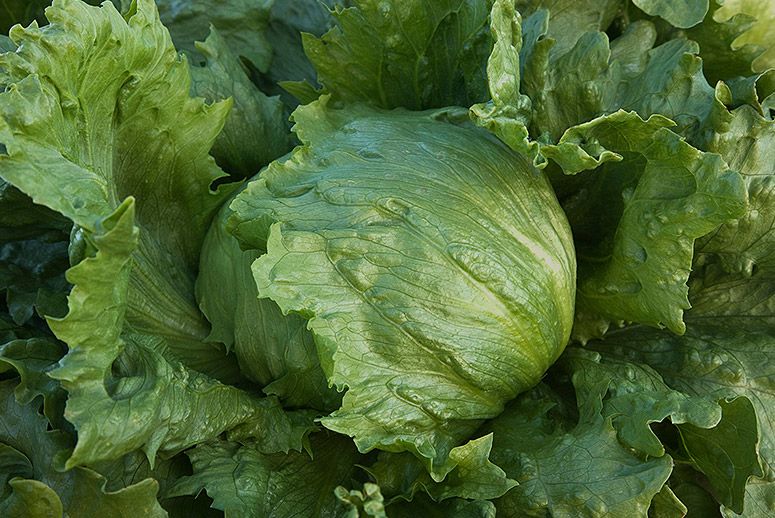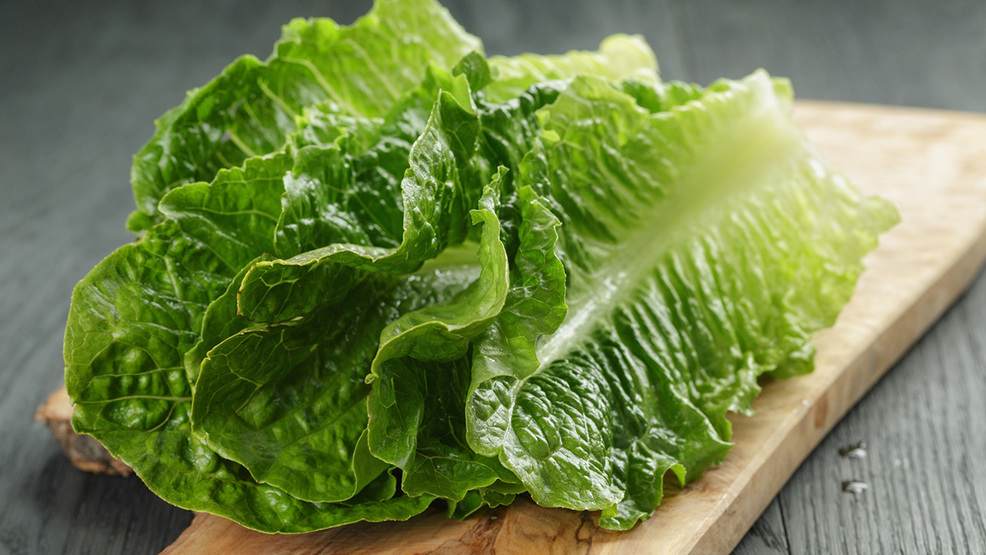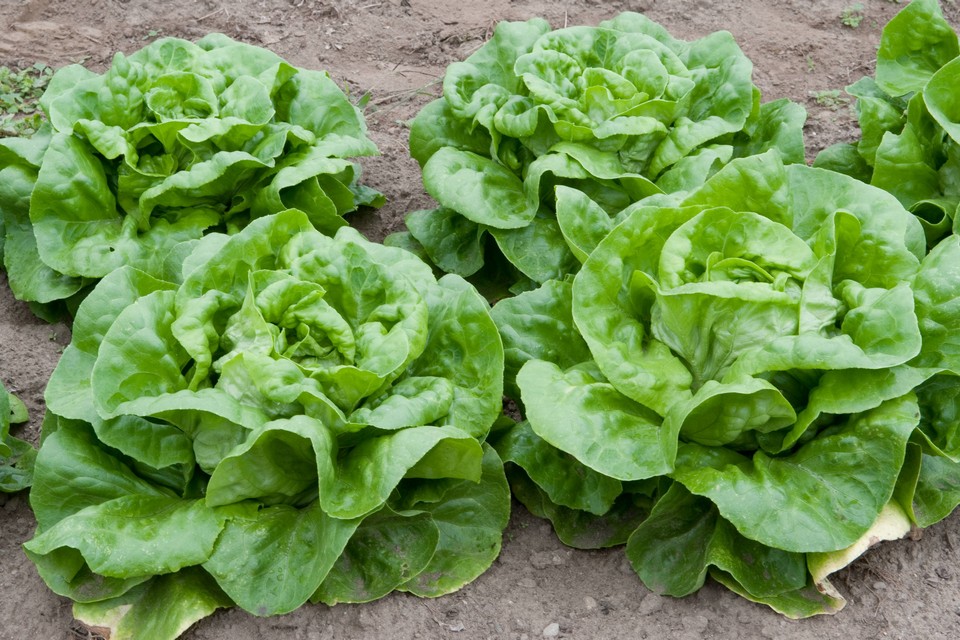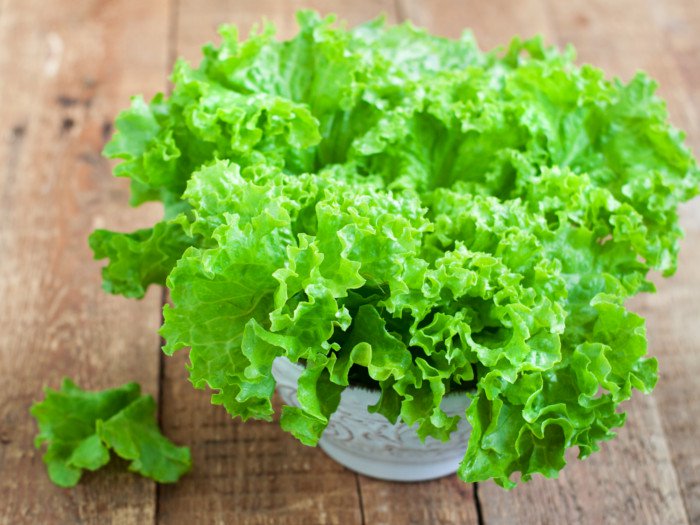Lettuce also known scientifically as Lactuca sativa is an annual plant belonging to daisy family Asterceae. It is cultivated as leaf vegetable sometimes for its seeds and stem. Firstly, it was cultivated by ancient Egyptians who turned it from a weed and seeds were used for producing oil, a food plant which is grown for its succulent leaves.
Lettuce is a hardy annual cultivated in low temperatures in order to prevent it from flowering quickly. Native to Mediterranean and Siberia and it is also transported to parts of the world. Generally, the lettuce plant measures 6 to 12 inches in height with colorful mainly green leaves. Lettuce varies in shapes and textures from dense head to notched, frilly, scalloped or ruffly leaves.

Iceberg/Crisphead Lettuce | Source: takepart.com
History Of Lettuce
First, it was cultivated in ancient Egypt for producing oil from its seeds. The plant was bred by Egyptians into a plant cultivated for its edible leaves. Evidence shows the cultivation appeared as early as 2680 BC. It is considered as a sacred plant of reproduction god Min and is carried during festivals and placed near his images. The plant is believed to help god to perform sexual act with determination. It is used in creation of many images in wall paintings and tombs. Cultivated variety measures 30 inches long and resemble large version of modern romaine lettuce. Egyptians developed upright lettuce and passed to Greeks who shared with Romans.
In medieval writings, lettuce appeared as medicinal herb. It was mentioned by Hildegard of Bingen on medicinal herbs between 1098 and 1179. Joachim Camerarium provided descriptions in 1586 of romaine or cos lettuce, loose leaf lettuce and head lettuce. From Europe, Christopher Columbus brought it to Americas in late 15th century. In Europe, many varieties were developed in between late 16th century and early 18th century. In 1900s, the development of new packing, shipping technologies and storage improved lifespan and transportability of lettuce which resulted in increase in availability.
Description Of Lettuce

Romain Lettuce | Source: https://komonews.com
Lettuce’s native range spreads from the Mediterranean to Siberia, although it has been transported to almost all areas of the world. The Plants generally have a height and spread of 15 to 30 cm (6 to 12 in). The leaves are colorful, mainly in the green and red color spectrums, with some variegated varieties. There are also a few varieties with yellow, gold or blue-teal leaves. Lettuces have a wide range of shapes and textures, from the dense heads of the iceberg type to the notched, scalloped, frilly or ruffly leaves of leaf varieties. Lettuce plants have a root system that includes a main taproot and smaller secondary roots. Some varieties, especially those found in the United States and Western Europe, have long, narrow taproots and a small set of secondary roots. Longer taproots and more extensive secondary systems are found in varieties from Asia.
Depending on the variety and time of year, lettuce generally lives 65–130 days from planting to harvesting. Because lettuce that flowers (through the process known as “bolting”) becomes bitter and unsaleable, plants grown for consumption are rarely allowed to grow to maturity. Lettuce flowers more quickly in hot temperatures, while freezing temperatures cause slower growth and sometimes damage to outer leaves. The domestication of lettuce over the centuries has resulted in several changes through selective breeding: delayed bolting, larger seeds, larger leaves and heads, better taste and texture, a lower latex content, and different leaf shapes and colors.
Nutritional Value Of Lettuce

Butterhead Lettuce | Source: https://www.sandiegoseedcompany.com
Depending on the variety, lettuce is an excellent source (20% of the Daily Value, DV, or higher) of vitamin K (97% DV) and vitamin A (21% DV) (table), with higher concentrations of the provitamin A compound, beta-carotene, found in darker green lettuces, such as Romaine with the exception of the iceberg variety, lettuce is also a good source (10-19% DV) of folate and iron.
10 Health Benefits Of Lettuce

Loose-leaf Lettuce | Source: https://www.organicfacts.net
- Promotes metabolism: Metabolism is the reaction which converts the food we have consumed into energy that provides power to the body for doing something. Food nutrients have supportive role as well as control the chemical reaction of metabolism system. Lettuce has vital role in improvement of body metabolism. It possesses magnesium, iron and potassium which promotes metabolism of the body. Moreover, it is a great source of B-complex that enhances metabolism system.
- Lower heart problems: One must be aware and watch level of bad cholesterol in the body. The high presence of bad cholesterol results in cardiovascular diseases and other harmful diseases. Bad cholesterol causes strokes and heart attacks. Studies results the beta carotene and Vitamin C found in lettuce prevents the chances of cholesterol oxidation by preventing formation of plaques in artery walls that could block off and break the flow of blood. Potassium and fiber also assist in lowering level of cholesterol. Lettuce has fiber, potassium, beta-carotene and vitamin C which assist the heart condition.
- Lowers diabetes: Lettuce is helpful to lower the chances of diabetes. Lettuce contains few calories which makes glycemic index considered as zero. Low glycemic index is great for people who watch the level of blood sugar. The low content of blood sugar lowers the chances of diabetes. Consumption of lettuce regularly prevents the chances of suffering from diabetes.
- Lowers inflammation: Inflammation affects dental issues, migraines and pain on pack which could be avoided with the consumption of lettuce. The extracts of lettuce act as anti-inflammatory activity promoted by biocatalysts such as carrageenan and lipoxygenase. It is proved that lettuce has vital role to control inflammation.
- Prevent growth of cancer: Lettuce leaf possesses various nutrients which help to control various types of cancer. Moreover, research shows that it controls cells of leukemia and breast cancer. Similarly, the consumption of lettuce is essential to eliminate 50% of leukemia cells. Lettuce contains Vitamin A which helps to prevent cancer that assist in dealing chances of mouth cancer and lung cancer.
- Prevent microbes: Lettuce also possesses antimicrobial properties which is due to latex that deform upon yeasts. Biochemicals also assist body for acting as antimicrobial. This function is due to cardenolides and terpenes which defense the body from bad microbes.
- Promotes sleep: The condition of insomnia and sleep problem has become common nowadays. The consumption of lettuce regularly helps to deal with this problem. It is due to lactuacarium which is a white fluid which comes out when the lettuce leaves are cut. It assists relaxation and promotes quality of sleep. It is also found that lactuacarium provides similar properties to opium. One should not be worried as it does not provide any toxic side effects.
- Treat Alzheimer’s disease: An extract of lettuce provides control on neuron cell death which is caused by glucose or serum deprivation that assists in fighting Alzheimer’s disease. Neurons are vital parts of the body which has role in making memory. However, lettuce acts as neuroprotector that could be an aid for neurodegenerative diseases. Lettuce is used as a food to counteract the chances of this disease.
- Elimination of toxins: Lettuce can eliminate toxins which are due to minerals found in lettuce. It can balance acid. In addition, with the elimination of toxins in the body, only great substances are remained in the body. We could reap lots of health benefits from this lettuce.
- Antioxidant activity: Studies show that lettuce contains antioxidants that scavenge free radicals. Antioxidants have various biochemicals that could be found in diet and is essential for human health. An antioxidant obstructs free radicals that are produced during cellular metabolism. Free radicals could attack healthy cells, tissues and DNA inside it. It could also mutate healthy cells into cancerous cells which could develop various diseases. Antioxidants counteract these free radicals and neutralizes it before attacks of free radicals exists.
How To Eat Lettuce
- Lettuce is added to salads.
- Leaves are braised, stuffed, cooked or softened with cream, butter or pureed.
- Lettuce is used with vegetables, greens, cheese and meats.
- Use it in sandwiches, soups and wraps.
- It is used in meat dishes, bean curd and stir fry.
- Lettuce is used in sandwiches, burgers and wraps.
- Use entire head of lettuce in a smoothie
- Add lettuce to cheeseburger, baked salmon and chicken soup.
- The head of lettuce could be used in smoothie. The fruits should be blended first and then only the lettuce leaves should be added to the smoothie. The smoothie could be made with the fruits such as strawberries, bananas and mangoes with the head of romaine lettuce.
Types Of Lettuce
- Iceberg/ Crisp head: The leaves are greener on the outside and whiter on inside. It has got crisp texture, with juicy and mild taste. It is rich in choline.
- Romaine Lettuce: It has long and deep green leaves. It has a deeper taste with crispy texture. It is rich in Vitamin C, B2, A and B1.
- Butterhead: It has loose large leaves which are separated from its stem easily. It has a sweet flavor with soft texture.
- Loose-Leaf: It has broad and curly loose leaves. It has a crispy texture with delicate taste.
Traditional Uses Of Lettuce
- In folk medicine, it is used to treat pain, tension, rheumatism, coughs and nervousness.
- Use it internally for treating anxiety, insomnia, hyperactivity, neuroses, whooping cough, dry cough and rheumatic pain
- Use the sap externally for treating warts.
Some Tips On How To Prepare Lettuce
- The leaves should be washed in cold water. It should not be washed in running water because the leaves might be damaged, and it should be dried by patting the leaves.
- The bunch should be pound core hard by placing it on the chopping board so that the leaves would be loosened, and it will be easier to remove.
- In one hand hold the core firmly and on another hold lettuce, the core should be twisted to separate the leaves.
- The leaves should be placed in a salad pinner to dry. It should be teared so that it does not get bruised.
- The salad should be dressed just before serving it so that the leaves are crispy.
Some Interesting Facts About Lettuce
- The largest producer of lettuce is China.
- Crisp head, butterhead, romaine and loose-leaf are four main types of lettuce.
- Besides potatoes lettuce is the second popular vegetable.
- Ancient kings of Persia consumed lettuce 2500 years ago.
Watch This: 8 Reasons to Eat Lettuce
About Lettuce
Lettuce was cultivated by Egyptians thousands of years ago. Today, it can be found all over the world. It can be used to treat a variety of illnesses. Some of its health benefits includes promotes sleep, elimination of toxins, prevents growth of cancer just to name a few. It is used in salads and other foods.







